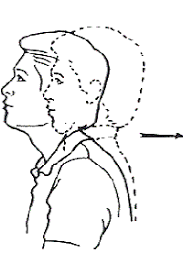At a networking event last week, I was asked if we see many patients with whiplash. I replied that we do, and it's
one of the most common problems we treat in the clinic. Here is some information about how whiplash is caused and
what you can do if you are suffering from WAD.
 |
| www.sciencephoto.com ow.ly/cxH2e |
Whiplash (or to give it its Sunday name: Whiplash Associated Disorder) can be a very debilitating disorder, but
on a brighter note, is usually short-lived. The name "whiplash" refers to the mechanism of injury rather than the injury itself. Most of us associate it with car accidents, but in fact it is quite common for whiplash to be seen after
contact sports injuries or falls - anything where the body is travelling at speed in one direction and then is suddenly stopped or rapidly thrown in the other direction, "whipping" the head as it goes.
This all sounds very painful.
The symptoms usually include inflammation (redness, heat, swelling, immobility and, yes indeed, pain) and
bruising to the soft tissues and joints in the spine. These might include the cervical (neck) muscles, intervertebral discs and joints, the vertebrae (bones) themselves, nerves, ligaments and tendons. You might also feel
stiffness in your neck, and muscle spasms around your neck, shoulders and into your arms.
Still more bad news to come, but don't worry,
it gets happier soon...
You may also feel some stranger symptoms such as
pins and needles, numbness or altered sensation in your arms and hands, along with
dizziness or headaches. And it is not unusual for any of these symptoms to appear
hours or even days after the accident or fall.
Ok, now for some reassurance.
Although you may be experiencing some or all of these symptoms, it is important to remember that
no serious damage has been caused. It is most likely that these symptoms are caused by the neck not moving properly, and not by any permanent or serious damage.
Phew!
The symptoms may persist but the body has a natural ability to repair and restore itself. Bear in mind these tips for
things that you can do to help speed up this process.
 |
| www.nortechlabsonline.com ow.ly/cxHuh |
Pain Relief
If you've seen your GP, you may already have been prescribed painkillers and anti-inflammatories (such as ibuprofen) and these can help you manage your pain in the first few weeks. You might also find that using an
ice pack or heat pack can help alleviate some of the worst symptoms. One more thing: whiplash symptoms are generally worsened by tension so
keeping your stress levels to a minimum and trying to relax your muscles can really help.
Posture
We physiotherapists do love to nag about posture, but seriously: maintaining good posture while sitting, driving and standing will support their muscles in their optimal position. If you sit at a desk or spend long periods in one position, try not to slouch and do take regular breaks. Performing gentle movements of your neck and shoulders will also help stop you from stiffening up.
Sleeping
It's really important to keep your head supported when you're sleeping - in other words, do not sleep without a pillow! Depending on your
size and your sleeping position, the number of pillows you require will vary but remembering that your head should remain in line with the rest of your body will help you choose the right pillow set-up. If you sleep on your
back, one pillow should support you, and if you sleep on your
side, two pillows is usually right. The thickness and firmness of your pillows will also have an effect.
Exercise
Keep moving. It is important
not to let your muscles stiffen up any more than they already have. The earlier you get things moving, the sooner the symptoms will settle.
Try not to avoid too many activities (such as washing your hair, walking the dog) as early return to these can be helpful. Prolonged inactivity slows down recovery and may cause symptoms to worsen.
Some activities may involve pain but this is rarely harmful.
So, here are some simple exercises you can do to help alleviate your whiplash symptoms.
Neck retractions
 |
| www.bone-clinic.com ow.ly/cxHKL |
Sitting or standing in an upright position,
pull your chin in as shown. Your head should not tip forwards or backwards, but should stay in a neutral position. You should feel a stretch up the back of your neck. Repeat 10 times.
Side flexion
Bend your head to one side, bringing your ear down towards your shoulder. You should feel a stretch on the opposite side of your neck. Hold for 5 seconds, the repeat on the other side.
Rotation
Turn your head to look over your shoulder. You should feel a stretch in the opposite side of your neck. Hold for 5 seconds, then repeat to the other side.
Each of these exercises is meant to be undertaken after you have sought medical advice, and along with physiotherapy treatment. If you are suffering from whiplash,
contact us now on 01412372721 to book an appointment or to take advantage of one of our free 15 minute consulations.